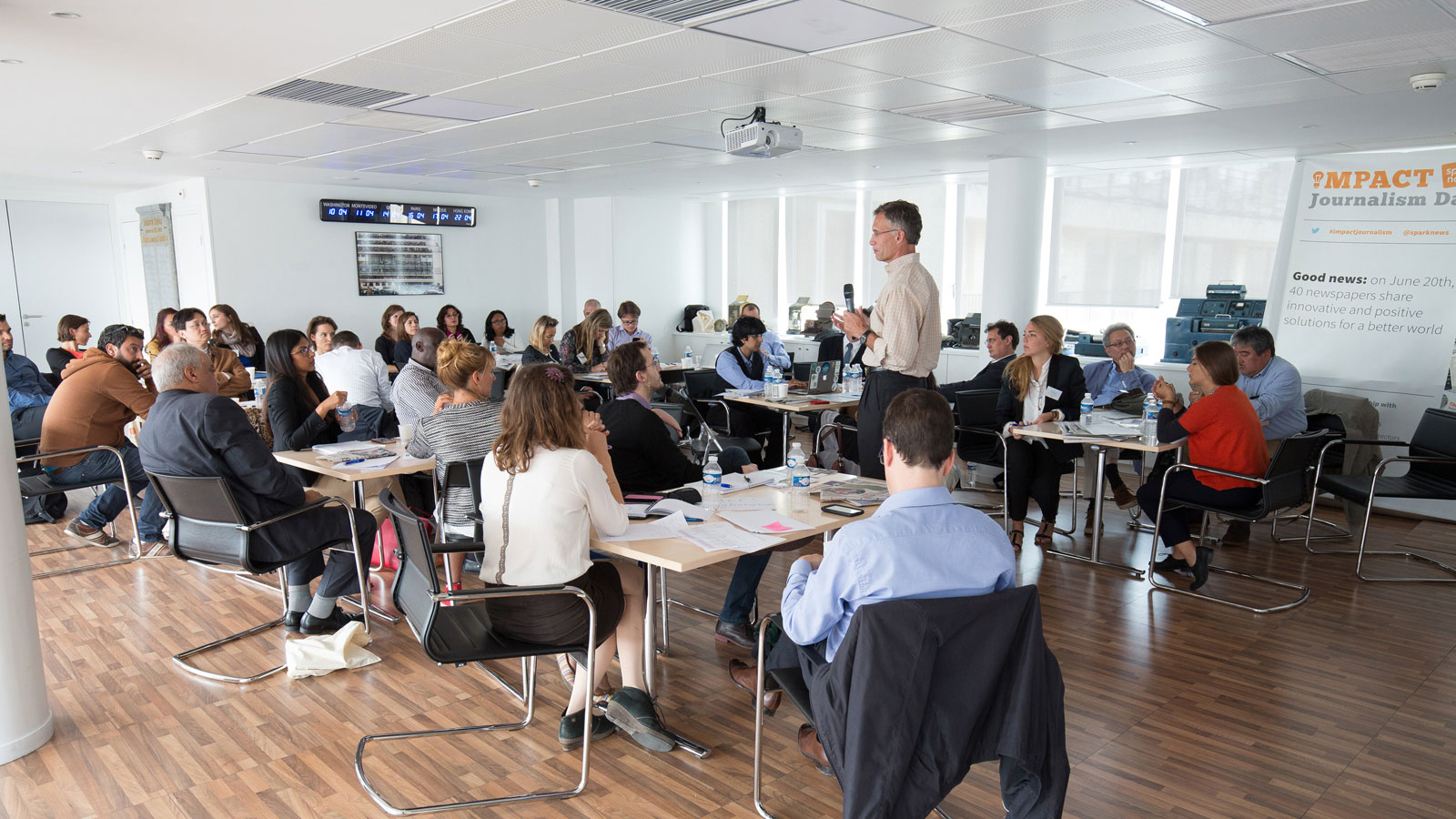Pokud čtete tento manuál, znamená to, že máte – alespoň minimální – zájem o Solutions Journalism, tedy žurnalistiku zaměřenou na řešení, a zajímá vás, jak by mohla vylepšit vaše zpravodajské dovednosti. Skvělé. Jsme přesvědčeni, že pokud se novináři zabývají řešením problémů, hodně tím získají.
Spousta zajímavých příběhů zůstává nepovšimnuta a nepíše se o nich. Proč? Novinářská obec bývá vůči řešením, coby legitimnímu materiálu pro investigaci, tradičně rezistentní. Někteří novináři a editoři se obávají, že to bude považováno za advokační činnost (obhajoba konkrétních zájmů), zbytečnou vatu nebo PR. Naším posláním v organizaci Solutions Journalism Network (SJN) je toto vnímání změnit. Žurnalistiku zaměřenou na řešení definujeme jako kvalitní a přesné zprostředkování informací o reakcích na společenské problémy – zpravodajství prováděné v nejvyšším novinářském standardu.

Aktuálně pracujeme s více než 170 newsroomy a tisíci jednotlivých novinářů, abychom ukázali, že solidní žurnalistiky orientované na řešení se nemusíme bát. Naopak jde o důležitý a málo využívaný nástroj z novinářské výbavy.
SJN založili David Bornstein a Tina Rosenberg, zkušení žurnalisté píšící pro New York Times do rubriky Fixes (Řešení) spolu s Courtney E. Martin, novinářkou, která začínala právě v době, kdy začínal strmě narůstat vliv online médií. Každý z nich měl za sebou jedinečnou cestu – ať už po zemědělských oblastech v Indii, nemocnicích v Brazílii nebo v Devátém obvodě New Orleans – která je všechny dovedla ke stejnému závěru: mezi novináři není dostatek zdravého soutěžení ve vztahu k velkým příběhům o řešeních společenských problémů po celém světě.

Tradiční myšlení říká: pokud se budeme zabývat řešeními, mohli bychom se zpronevěřit své profesionalitě. Nové myšlení oponuje: profesionalitě se zpronevěříme, pokud se řešeními zabývat nebudeme. Úkolem nás novinářů je nastavovat společnosti pravdivé zrcadlo. Pokud neinformujeme o různých způsobech, jak se lidé a instituce pokouší řešit problémy – ať už úspěšně či nikoli – neděláme svou práci dobře. Pokud například píšeme jen o systémových problémech ve školství, ale pomíjíme modelové příklady, které vzdělávání zlepšují, nevyprávíme celý příběh.
Mnozí z nás se stali novináři, protože chceme, aby naše práce měla dopad, chceme zlepšovat svět. Ale odhalování darebáctví není jediným způsobem, jak něco ovlivnit. Odkrývat problémy je samozřejmě zásadní – ovšem dopad se ještě více zvětšuje v případě, že společně s problémy informujeme i o tom, jak je lidé řeší. Například novináři píšící o vzdělávání přinášejí šokující příběhy o tom, jak veřejné školy nechávají propadávat chudé děti. Jejich články by ale měly větší dopad, kdyby také psali o tom, jak některé jiné školy vzdělávají všechny své studenty a jak to dokázaly. Takové příběhy dodávají čtenářům, posluchačům a divákům energii. Takové příběhy mění veřejnou debatu. A mění vládní politiky.
Lidé se nemění jen proto, že někdo poukázal na jejich problémy. Potřebujeme vědět, že změna je možná, a vidět ukázkové příklady, jak jí dosáhnout. Společnosti fungují stejným způsobem.
Tento manuál je navržen pro všechny, kdo chtějí praktikovat žurnalistiku zaměřenou na řešení. Doufáme, že pro vás tyto stránky budou přínosné, ať už jste zkušená píšící novinářka, která chce oživit svůj přístup, nebo televizní reportér uprostřed své kariéry, který se chce vrátit k původním důvodům, proč se stal novinářem, či studenti žurnalistiky hledající směr pro svou profesní dráhu. Anebo cokoli mezi tím.
Manuál provází uživatele praxí žurnalistiky zaměřené na řešení od prvního až do posledního kroku – od identifikace řešení, které by stálo za prozkoumání, až po zapojení čtenáře či diváka do vašeho výtvoru, jakmile je zveřejněn. Nemusíte ale pročítat tento text od začátku do konce jako tradiční knihu. Můžete si vybrat jen části, které jsou pro vás nejužitečnější.
Vyextrahovali jsme strukturu několika novinářských příběhů zaměřených na řešení, abychom vám pomohli v případě autorského bloku. Ve všech částech manuálu najdete videa a interaktivní cvičení, které přístup zaměřený na řešení uvádějí do reality. Dále zde najdete odkazy na případové studie a modelové příběhy z naší databáze příběhů orientovaných na řešení (Solutions Story Tracker) a také odkazy na další zdroje na naší webové stránce i jinde. K tomu jsme ještě vytvořili zvláštní průvodce pro reportéry specializující se na problematiku zdraví, vzdělávání a násilí.
Tento dokument chápeme jako pracovní, a proto uvítáme vaši zpětnou vazbu. Prosíme, dejte nám vědět přes e-mail, twitter nebo třeba poštovním holubem. Přivítáme jakékoli doporučení, které nám pomůže tento text vylepšit a učinit ho ještě užitečnější pro všechny, kdo chtějí praktikovat Solutions Journalism.
Těšíme se na brzké reakce z vaší strany!
